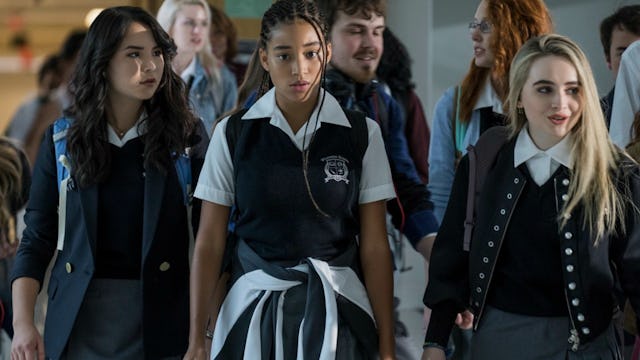Why Every White Person Needs To See 'The Hate U Give'

It’s Thursday evening, and my second daughter is off selecting the bedtime book while I instruct the other kids to lay on the living room floor. My daughter is quite active, a fan of sports and superheroes. But she doesn’t bring me a book about Black Panther (her current favorite superhero) or basketball, but instead a book about what black children should do when encountering police officers.
This wasn’t exactly the “sweet dreams” bedtime story I was hoping to read my children that night. But I wait until my four kids settle, and then I read them the book anyway. They listen, mostly attentive and engrossed, as I force myself to keep my voice steady.
I know this is my parental duty, to prepare my children for the realities they will face. It’s not easy, but it is necessary.
Three days later, I sit in a darkened theater to watch The Hate U Give, an adaptation of author Angie Thomas’ bestselling young adult novel. Actors Amanda Stenberg, Common, Regina Hall, and Issa Rae, among several others, tell the story of 16-year-old Starr who witnesses her childhood best friend get shot by a white police officer during a traffic stop.
I was both excited and dreading the release of this film. Yes, I’d read the novel. In fact, I devoured it in just three days, sneaking off to read a few pages whenever I could. I’d marked the movie release date in my calendar, making sure I blocked off an afternoon to go see it with a few fellow moms who are also part of multiracial families.
But with every sneak peak I viewed online, I became increasingly anxious about watching the movie on the big screen. Because what happens to Starr isn’t just a story to pass the time on a Sunday afternoon. What happens to Starr is personal, a possibility of what could happen to one my own four kids.
Starr is a typical teenager, juggling SAT prep, a boyfriend, friends, family relationships, and finding her voice. But Starr is caught between two worlds. She attends a predominately white school, but lives in a black neighborhood, in a black family. She admits that she exists as two people, and depending on where she is, she elicits one of the two.
When Starr’s childhood friend is killed, Starr has a big choice to make: does she stand up for her deceased friend by sharing what happened, or does she keep quiet? Choosing to speak out will have major consequences, but choosing to not share is eating her up inside.
I don’t want to spoil the book or movie for anyone, but I will say that watching Starr, a passionate, smart, beautiful young woman face a life-altering decision while confronting the trauma of watching her friend die on the street has shaken me to my core.
When my husband and I decided to adopt after I faced a difficult diagnosis, we also decided that we would be open to adopting a child of any race. We didn’t do this with the belief that “love conquers all.” In fact, we did the research. Lots and lots of research. We read books, blogs, and articles, we watched documentaries, we met with other multiracial families. We wanted to be prepared to parent a child of color.
Now, here we are, four children and a decade later. My oldest was born the same month Barak Obama was elected to be the first black president. My second daughter turned one year old on the day Tamir Rice was killed by police. My young son, our third child, was called a “cute little thug” by an acquaintance just a month or so after Michael Brown was shot in Ferguson, located just thirty minutes from our home. My fourth child, a baby girl, arrived two months before Donald Trump was elected to be the country’s next President.
Let me say, experience is the best teacher. However, when two white parents don’t have the same experiences as black people, we had to go to others to help us raise our children, preparing them to become black adults. Because we realized that in the blink of an eye, white adults who called our young children “so cute” were beginning to see our children as threats.
Watching Starr’s story unfold, I wished I could entice every white person to go see the film. To consider the narrative of a young black person, on the brink of young adulthood. I want others to see my children and all children of color as human beings who, because of the melanin in their skin, face danger and constant trauma simply because they exist.
The film forces us to consider our own choice. Do we dare to empathize, to truly understand, what black people in our county are facing every day? Or will we dig our heels in even harder and demand that we, as white people, are right to sit back, judge, and desensitize ourselves in order to preserve our long-standing privilege?
Society is sick, and The Hate U Give diagnoses us.
What we do after seeing the film is our choice. For the sake of humanity and especially the four souls I have the honor of parenting, I hope we choose empathy. And after empathy, action. And after action, equality.
This article was originally published on